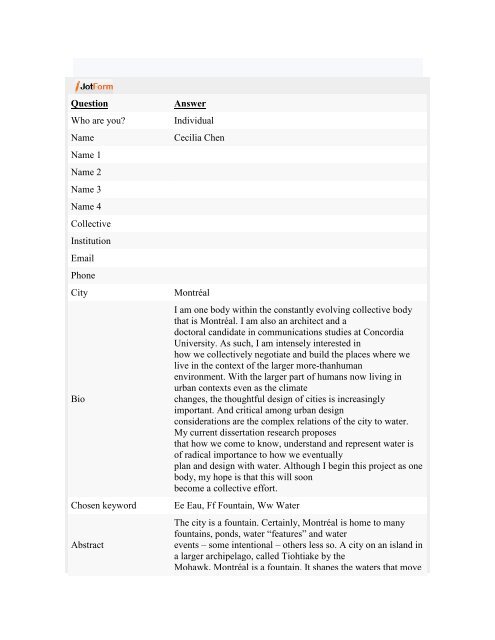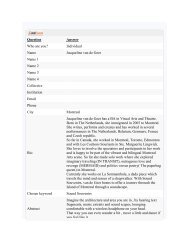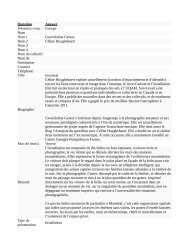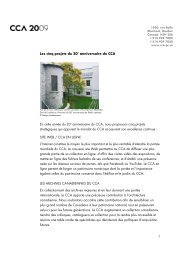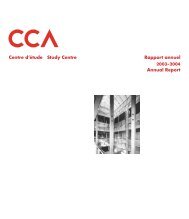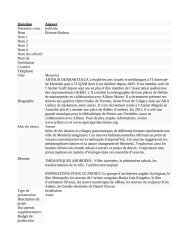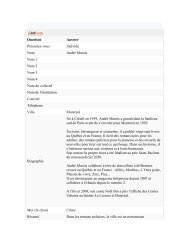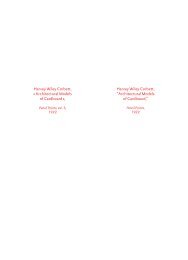Question Answer Who are you? Individual Name Cecilia Chen ...
Question Answer Who are you? Individual Name Cecilia Chen ...
Question Answer Who are you? Individual Name Cecilia Chen ...
You also want an ePaper? Increase the reach of your titles
YUMPU automatically turns print PDFs into web optimized ePapers that Google loves.
<strong>Question</strong> <strong>Answer</strong><br />
<strong>Who</strong> <strong>are</strong> <strong>you</strong>? <strong>Individual</strong><br />
<strong>Name</strong> <strong>Cecilia</strong> <strong>Chen</strong><br />
<strong>Name</strong> 1<br />
<strong>Name</strong> 2<br />
<strong>Name</strong> 3<br />
<strong>Name</strong> 4<br />
Collective<br />
Institution<br />
Email<br />
Phone<br />
City Montréal<br />
Bio<br />
I am one body within the constantly evolving collective body<br />
that is Montréal. I am also an architect and a<br />
doctoral candidate in communications studies at Concordia<br />
University. As such, I am intensely interested in<br />
how we collectively negotiate and build the places where we<br />
live in the context of the larger more-thanhuman<br />
environment. With the larger part of humans now living in<br />
urban contexts even as the climate<br />
changes, the thoughtful design of cities is increasingly<br />
important. And critical among urban design<br />
considerations <strong>are</strong> the complex relations of the city to water.<br />
My current dissertation research proposes<br />
that how we come to know, understand and represent water is<br />
of radical importance to how we eventually<br />
plan and design with water. Although I begin this project as one<br />
body, my hope is that this will soon<br />
become a collective effort.<br />
Chosen keyword Ee Eau, Ff Fountain, Ww Water<br />
Abstract<br />
The city is a fountain. Certainly, Montréal is home to many<br />
fountains, ponds, water “features” and water<br />
events – some intentional – others less so. A city on an island in<br />
a larger archipelago, called Tiohtiake by the<br />
Mohawk, Montréal is a fountain. It shapes the waters that move
Medium<br />
through it from upstream to downstream.<br />
All its inhabitants (plant and animal) and all its matter (mineral,<br />
metal, synthetic and composite) act together<br />
to influence the way water moves through the city – as well as<br />
radically altering its biochemistry. Currently,<br />
Montréal as a fountain finds a rather everyday and ignoble<br />
outlet in the wastewater treatment plant at the<br />
downstream end of the island. With intense rainfall earlier this<br />
summer the city became a site of flash<br />
flooding as its limited and aging water infrastructures failed<br />
miserably to deal with a changing climate. Our<br />
urban infrastructures do not celebrate water – as all good cityfountains<br />
should! The intent of this project is<br />
to celebrate water in the city and to ask Montrealers to propose<br />
ways in which we might make the city a<br />
better fountain – an urban environment designed inclusively<br />
with water and its more-than-human generative<br />
force.<br />
Workshop/Public program<br />
Installation<br />
Other<br />
Project statement 120731_chen_abc_mtl_cca_statement.pdf<br />
Supporting documents 120731_chen_abc_mtl_cca_supporting.pdf<br />
Budget 120731_chen_abc_mtl_cca_budget.pdf
Proposal for ABC : MTL – Canadian Centre for Architecture<br />
City as Fountain – eau! o! (take me to <strong>you</strong>r water)<br />
Possible Keywords<br />
Abstract<br />
Ee Eau<br />
Ff Fountain<br />
Ww Water<br />
The city is a fountain. Certainly, Montréal is home to many fountains, ponds, water “features” and water<br />
events – some intentional – others less so. A city on an island in a larger archipelago, called Tiohtiake by the<br />
Mohawk, Montréal is a fountain. It shapes the waters that move through it from upstream to downstream.<br />
All its inhabitants (plant and animal) and all its matter (mineral, metal, synthetic and composite) act together<br />
to influence the way water moves through the city – as well as radically altering its biochemistry. Currently,<br />
Montréal as a fountain finds a rather everyday and ignoble outlet in the wastewater treatment plant at the<br />
downstream end of the island. With intense rainfall earlier this summer the city became a site of flash<br />
flooding as its limited and aging water infrastructures failed miserably to deal with a changing climate. Our<br />
urban infrastructures do not celebrate water – as all good city-fountains should! The intent of this project is<br />
to celebrate water in the city and to ask Montrealers to propose ways in which we might make the city a<br />
better fountain – an urban environment designed inclusively with water and its more-than-human generative<br />
force.<br />
Bio<br />
I am one body within the constantly evolving collective body that is Montréal. I am also an architect and a<br />
doctoral candidate in communications studies at Concordia University. As such, I am intensely interested in<br />
how we collectively negotiate and build the places where we live in the context of the larger more-thanhuman<br />
environment. With the larger part of humans now living in urban contexts even as the climate<br />
changes, the thoughtful design of cities is increasingly important. And critical among urban design<br />
considerations <strong>are</strong> the complex relations of the city to water. My current dissertation research proposes<br />
that how we come to know, understand and represent water is of radical importance to how we eventually<br />
plan and design with water. Although I begin this project as one body, my hope is that this will soon<br />
become a collective effort.<br />
City as Fountain Proposal for ABC : MTL – Canadian Centre for Architecture – C.<strong>Chen</strong> - 120731 . . . 1 of 5
Project Statement<br />
The city is a fountain. Certainly, Montréal is home to many fountains, ponds, water “features” and water<br />
events – some intentional – others less so. A city on an island in a larger archipelago, called Tiohtiake by the<br />
Mohawk, Montréal is a fountain. It shapes the waters that move through it from upstream to downstream.<br />
All its inhabitants (plant and animal) and all its matter (mineral, metal, synthetic and composite) act together<br />
to influence the way water moves through the city – as well as radically altering its biochemistry. Currently,<br />
Montréal as a fountain finds a rather everyday and ignoble outlet in the wastewater treatment plant at the<br />
downstream end of the island. With intense rainfall earlier this summer the city became a site of flash<br />
flooding as its limited and aging water infrastructures failed miserably to deal with a changing climate. Our<br />
urban infrastructures do not celebrate water – as all good city-fountains should! The intent of this project is<br />
to celebrate water in the city and to ask Montrealers to propose ways in which we might make the city a<br />
better fountain – an urban environment designed inclusively with water and its more-than-human generative<br />
force.<br />
What is a fountain? It is a conscious and jo<strong>you</strong>s expression of water. Well-known Roman examples<br />
such as the Trevi fountain celebrate the arrival of aqueducts in the city. This kind of fountain venerates its<br />
source with exubertant jets. But not all fountains celebrate water in the same way. Other, more<br />
contemporary fountains <strong>are</strong> given form by conscientious artists such as Basia Irland (see her Desert<br />
Fountain), artist and architect Maya Lin (see her many installations involving water, particularly her design for<br />
three phases of water in the Ecliptic park at Rosa Parks Circle in Grand Rapids, Michigan), and gh3<br />
Architects and Landscape Architects with their SWQF (Storm Water Quality Facility) in Toronto’s West<br />
Don Lands – a building that is also a fountain. Recent wastewater management lore has recognized the<br />
sophistication and complex biodiversity of restoring wetlands and adding meanders back to river courses.<br />
These <strong>are</strong> only some of the many inspiring examples of design approaches that celebrate water.<br />
Some Theoretical Background<br />
A recurring place and re-iterated articulation of water for many humans is now the city. These densely<br />
settled <strong>are</strong>as embody great risks and potentials in their intense socialized interactions with water. Waters<br />
move constantly between and through bodies, ecosystems and cities, enabling biological and meteorological<br />
transformations, including life, death, pollution and disease. Waters <strong>are</strong> always environmentally responsive<br />
and join us with the more-than-human into communities of sh<strong>are</strong>d waters. We need to understand our part<br />
in this hydrocommons. Consciously or not, we create the hydrocommons together with other humans,<br />
other creatures, multi-national corporations, industries and municipalities midst climate change. Waters<br />
shape and found cities even as cities influence and transform these same waters that in turn contribute to<br />
climatic patterns.<br />
By deliberately thinking about our relations to water – by thinking with water – we alter how we<br />
understand where we live and how we might build cities that truly respond to the hydrodynamic ethics<br />
entailed in living both upstream and downstream from many others. These hydrodynamics <strong>are</strong> obviously<br />
ecological, physical, geophysical, and meteorological – but they <strong>are</strong> also social, ethical, and political.<br />
Consider the architectural fabrics, systems, and complex bodies of cities. Cities shape how we live –<br />
from how we move within and through their actual constructions and in how we perceive what is valuable<br />
about the diverse and overlapping communities that they enable. To begin with, by irrigating the way we<br />
think and plan our cities, we necessarily place urban centres in relation to watersheds, rivers, lakes, aquifers,<br />
and regional infrastructures; we become aw<strong>are</strong> of the hydrophilic and hydrophobic bodies of plants, animals<br />
(including humans), gardens, parks, canals, roadways, buildings and the many sh<strong>are</strong>d places in-between.<br />
Current design and planning practices refer mostly to terrestrial property and political borders.<br />
Thinking cities with water deterritorializes or reterritorializes these practices critically and generatively – thus,<br />
enabling a way of thinking, planning and building that includes a more dynamic and complex systems-based<br />
approach to environment, biodiversity and urbanity. Where aspects of this environmentally and contextually<br />
City as Fountain Proposal for ABC : MTL – Canadian Centre for Architecture – C.<strong>Chen</strong> - 120731 . . . 2 of 5
sensitive thinking of built form and urban planning have been advocated and practiced at different times<br />
throughout the recorded history of architecture, this iteration – this particular instance of advocacy – is<br />
unique to a time when climate change is experienced globally (cyclones and hurricanes linked to warmer<br />
oceans) - and when weather events and water scarcity <strong>are</strong> both forefront in global conversations.<br />
The body of work that goes by the name of political ecology includes the work of Erik<br />
Swyngedouw, Maria Kaika, and Matthew Gandy, among others. All three of these scholars trace how waters<br />
<strong>are</strong> socialized within specific urban and environmental contexts. 1 Kaika, for one, points out that water<br />
pollution is never an “externality” – nature is not outside of human activity, humans <strong>are</strong> not outside of<br />
nature – but that anthropogenic transformation of rivers, lakes, aquifers and weather systems may be<br />
understood as our production of nature. 2 In this production of nature, cities have an increasingly important<br />
role to play. The politics of the city cannot be separated by the multiple and overlapping ecologies that cities<br />
effect and affect. As centers of intense activity, they amplify anthropogenic habits of dwelling and the<br />
subsequent transformations of lands, waters and populations of a hybrid urban ecosystem and watershed.<br />
The complex collective assemblage that is a city is both a hybrid socio-natural ecosystem and a<br />
messy prosthetic of human nature-culture improvised in collaboration with lively surrounds. Hybrid cities<br />
built deliberately with (and not just beside or over) water can offer generative approaches in a time when<br />
more than half the world’s humans and uncounted other species (dogs, cats, rats, cockroaches, pigeons,<br />
raccoons, crows, dandelions) <strong>are</strong> living in some form of urbanity.<br />
> collective production of the city<br />
> collective production of this project<br />
> participatory workshops and installation<br />
City as Fountain : Mapping Water in Montreal<br />
For this project, an approximately 3m x 3m space in the CCA galleries would host a permanent installation<br />
and self-explanatory mapping work space that invites the spontaneous participation of exhibit visitors. This<br />
work space would include a generous mapping table (with stools of varying height) onto which physcial<br />
maps can be laid flat, and onto which maps can also be projected from an appropriately located digital<br />
projector during workshops. On the adjacent walls, there will be a place to hang maps not in use as well as<br />
a shelf with supporting materials and a display screen linked to digitally accessible water mapping resources.<br />
In support and activation of this on-going mapping process, I propose to organise a series of guided<br />
workshops for mapping the relations of water in Montreal and for re-making the city as a fountain. I will also<br />
arrange for a complementary set of talks and walking tours (weather-dependant) that engage different<br />
aspects of water and urbanity. (See the proposed project schedule below for further details)<br />
Finally, I will regularly (about every two weeks) photograph, scan and upload selected materials<br />
from this ongoing mapping process – a project blog of sorts. Ideally, this online documentation would be<br />
hosted on an ABC : MTL (CCA) platform, but if this is not possible, I would find space to host this<br />
elsewhere.<br />
1 Maria Kaika examines the waters of Athens and London in City of Flows. Erik Swyngedous articulates a political<br />
ecology of water in his study of the Spanish waterscape between 1890 and 1930. Matthew Gandy critically narrates<br />
New York City’s thirsty relation to the Catskills through its extensive aqueduct systems.<br />
2 City of Flows, 21-24.<br />
City as Fountain Proposal for ABC : MTL – Canadian Centre for Architecture – C.<strong>Chen</strong> - 120731 . . . 3 of 5
List of supporting documents (compiled into a single pdf):<br />
images:<br />
accidental fountain (2 images)<br />
Accidental Fountain: Water from a buried stream and storm run-off pushes up through a manhole cover<br />
during an early spring thaw at the intersection of Peel and Sherbrooke Streets, Montréal, 2008.<br />
Station d’Épuration Jean-R-Marcotte<br />
Perspective looking down one of the shafts where the island-long gravity-fed combined storm and sewage<br />
interceptors terminate in the wastewater filtration plant at the downstream end of Montreal Island, near<br />
Pointe-aux-Trembles, 2009.<br />
Materiality / Matérialité – Queen / Dame – above / au dessus<br />
One of the cards I made during the Playing Cards workshop / Jeu de cartes, atelier, with Heather Davis as<br />
part of the exhibit: Promiscuous Infrastructures (Phase 2) / Infrastructures Entrelacées (Phase 2), curated by<br />
Artivistic (Faiz Abhuani, Sophie Le-Phat Ho and Kevin Lo – artivistic.org) at Skol Gallery, Montréal, 9 March<br />
– 14 April 2012.<br />
rapids basemap<br />
excerpt from a series of basemaps made for: Alternatives Journal (see link below), the mappingwaters<br />
website as well as my forthcoming chapter, “Mapping Waters: Thinking With Watery Place,” in Thinking<br />
With Water, to be published in 2013 by McGill-Queen’s University Press.<br />
other supporting documents:<br />
curriculum vitae (nine pages)<br />
full proposal minus list of supporting documents (four pages – abstract, bio, statement, budget+schedule)<br />
see also:<br />
http://www.alternativesjournal.ca/articles/mapping-watery-relations-at-the-lachine-rapids<br />
http://www.mappingwaters.seecechen.org/content/pumpkins-flood<br />
http://thinkingwithwater.net/content/about-project<br />
City as Fountain Proposal for ABC : MTL – Canadian Centre for Architecture – C.<strong>Chen</strong> - 120731 . . . 4 of 5
cecilia chen<br />
EDUCATION<br />
RESEARCH DEGREES<br />
Doctoral Candidate (ABD), Concordia University<br />
Joint Doctorate in Communication, Concordia University (with Université de Québec à Montréal and<br />
Université de Montréal), Montréal. Dissertation: “Mapping Waters” advisor: Dr. Peter C. van Wyck.<br />
Master of Architecture, Post-professional, McGill University (2005)<br />
Post-professional Master’s Program, Cultural Landscapes (now part of the Cultural Mediations and<br />
Technology program), School of Architecture, McGill University, Montréal. Research Project: “Constructing<br />
Pacific Mall” advisor: Dr. Annmarie Adams.<br />
PROFESSIONAL CERTIFICATIONS AND DEGREES<br />
Architecte, membre de l’Ordre des architectes du Québec, OAQ, (2008)<br />
Professional registration in Quebec; internship experience from Toronto and Montréal. Exams written:<br />
NCARB (National Council of Architectural Registration Boards) ARE (Architectural Registration Exams) series;<br />
examen d’admission OAQ, 2007; other OAA and OAQ courses.<br />
Bachelor of Architecture, University of Waterloo (1995)<br />
Professional degree, School of Architecture, University of Waterloo, Waterloo, Ontario, thesis project: “Settle<br />
– Inhabiting Dundas Street.” Including Rome Program and Pescara Studio (University of Waterloo / Università<br />
di Chieti, 1993-1994) overseas study in Rome and Pescara, Italy.<br />
Bachelor of Environmental Studies, University of Waterloo (1992)<br />
Pre-professional degree, School of Architecture, University of Waterloo, Waterloo, Ontario.<br />
LANGUAGE CERTIFICATIONS<br />
French Language Proficiency, Office québécois de la langue française (2006)<br />
Successful completion of four exams: reading and aural comprehension, oral and written expression.<br />
Professionals from out-of-province must prove their ability to practice entirely in French (article 35 of<br />
Québec’s Charte de la langue française).<br />
Mandarin Chinese Studies, Beijing Language and Culture University (2000)<br />
Certificate of Chinese Proficiency (HSK 5) five month intensive study program, Beijing, PRC.<br />
cv 1 of 9
WORK EXPERIENCE<br />
TEACHING POSITIONS<br />
2009 Winter – “Media and Cultural Context” COMS 367<br />
Instructor, Department of Communication Studies, Concordia University, Montréal. A required undergraduate<br />
course (mostly second year) within the Communication Studies Bachelor’s program, 35 students, course<br />
materials selected by instructor within outline of course parameters.<br />
2008 Winter – “Mass Communications” COMS 360<br />
Instructor, Department of Communication Studies, Concordia University, Montréal. A required undergraduate<br />
course for many degree programs across the humanities, 48 students, predetermined course materials<br />
combined with materials selected by instructor.<br />
2008 Fall – “Duality, Dissent and Design” GDD 325<br />
Instructor, Graphic Design and Digital Media Program, Champlain College in Vermont, Study Abroad<br />
Program, Montréal. This course was co-created and co-taught with Andrew Forster as a pilot effort to<br />
establish a new international study program for graphic design students from Burlington, Vermont (program<br />
director: David Lustgarten). Our emphasis was on the relations between cultural context, urban context and<br />
design.<br />
2007 Winter – “International Communications” COMS 473<br />
Teaching Assistant, for Dr. Monika Kin Gagnon, Department of Communication Studies, Concordia<br />
University, Montréal. Marking and other assistance.<br />
2007 Summer – “Dessin 2”<br />
Instructor, Chaya Mushka Seminary (College), Cégep Marie-Victorin, Montréal. This college level drawing<br />
course emphasized basic observation skills and culminated with constructing hand-drawn perspectives. It<br />
was part of an Interior Decoration certificate program tailored for Jewish women.<br />
1999-2012 – Guest Critic<br />
Invited Guest Critic at various Schools of Architecture, Université de Montréal, University of Waterloo, McGill<br />
University. Most recently (June 2012), guest critic for a sustainable design studio taught by Danny Pearl and<br />
Sudhir Suri at the Université de Montréal; (2004-2009) regular guest critic for the University of Waterloo’s<br />
summer studio in Montréal taught by M-P. Macdonald.<br />
SELECTED ARCHITECTURAL WORK EXPERIENCE – OFFICES<br />
Jan 2005-Aug 2006 – Fournier Gersovitz Moss architectes et associés, Montréal<br />
Reference: Julia Gersovitz or Alain Fournier. Schematic design, code reviews, conservation and restoration<br />
work, building surveys, design development, construction documents coordination and execution, or project<br />
management – for various projects in Nunavik, Toronto and Montréal.<br />
Responsibilities included: A) Job captain for the renovation and restoration of a 19th century w<strong>are</strong>house,<br />
McGill Street, Montreal. Built over a section of the old city walls, the design and permit processes were<br />
complicated by considerations of the city’s archeological heritage. These new offices for a Saint-Petersburg based<br />
shipping company accommodate work <strong>are</strong>as, meeting rooms, a café/lunch room, walk-out roof terrace, executive<br />
suites, a multi-storey light-well and a generous lobby. (4-storeys, 1,200 m 2, $2.5 million, 2007). B) Construction<br />
documents execution and coordination for a community centre in Kangiqsujuaq, Nunavik, an Innu<br />
community in northern Quebec. C) Schematic and developed designs for various other northern projects (housing,<br />
2 of 9
dayc<strong>are</strong> and community pool building). Most buildings built on permafrost need to be supported above the ground<br />
with a belly of reservoirs for drinking water, oil for heating and wastewater – all supplied and removed by truck.<br />
Apr 2000-Aug 2003 – Diamond Schmitt Architects Incorporated, Toronto<br />
Reference: Mike Szabo. Design development, execution and coordination of construction documents,<br />
specifications, costing, fast-track project management, contract and site administration.<br />
Responsibilities included: A) Coordination for landscape and services for the University of Ontario<br />
Institute of Technology (UOIT) Masterplan, Phase I (DSAI in association with duToit Allsopp Hillier). Working<br />
with Mike Szabo, Don Schmitt, John Hillier and other consultants, I coordinated the masterplan with civil<br />
infrastructures and landscape designs to give coherence to new and existing buildings centred around a commons<br />
above ground (pedestrian paths, site lighting, pool, pergola with wifi, benches, plantings) and a commons below<br />
ground (a subterranean network of service tunnels, building infrastructures and a geo-thermal heat exchange<br />
system). The entire campus, including parking and roads, was designed to drain to a series of strategically and<br />
decoratively planted swales and ponds to filter surface runoff before returning them to Oshawa Creek. (40<br />
hect<strong>are</strong>s / 100 acres campus, first phase of landscaping: $20 million, completed September 2004). B) Site<br />
administration, interiors coordination and lighting design for the Bahen Centre for Information Technology<br />
(BCIT), University of Toronto: Working with Thom Pratt, David Dow, Matthew Lella, Dale McDowell and others,<br />
I designed, coordinated and administered work on the atrium interiors, lighting, ceilings, and the renovation and<br />
restoration of a historical house incorporated into the new building. (8-storeys, 36,800 m 2, $100 million,<br />
completed September 2002).<br />
Nov 1996-Aug 1999 – Oleson Worland Architect, Toronto<br />
Reference: David Oleson. All stages of design work, from proposals through to construction sets.<br />
Working with David Oleson, Christie Pearson and Howard Wong at this small firm was an excellent<br />
experience. David fostered a collaborative, supportive, and open-minded approach to design. One of the projects I<br />
worked on while at OWA was Camden Lofts (29 Camden Street, Toronto, with Core Architects). This modest newbuilt<br />
downtown condominium project mimicked a w<strong>are</strong>house vocabulary and extended a density of inhabitation<br />
appropriate to the city centre. I worked on this project from initial design, marketing, development, permit, working<br />
documents, coordination, bidding, construction administration, to on-site inspections and reporting. Other projects<br />
included: University of Toronto Athletics Centre, Lockers Renovation, Trinity Bellwoods Recreation Centre<br />
Renovation, Master Plan for University of Toronto Athletics Centre, Envelope Renovation for 2 County Court<br />
Boulevard, Brampton (office building), Woodbine Park Master Plan Study.<br />
DESIGN COLLABORATIONS<br />
Jan-Feb 2005 – Partenariat du Quartier des Spectacles Workshop, Montréal<br />
collectif dab (Steve Topping, Frances Stober, Tony Round, Ana Rewakowicz, Lorraine Oades, Marie-Paule<br />
Macdonald, Andrea Kordos and myself) was an interdisciplinary team of artists and architects. The<br />
Partenariat du Quartier des Spectacles sought to ‘brand’ an <strong>are</strong>a of Montréal’s downtown, known for<br />
theatres, summer festivals, and its redlight district. Referencing Guy Debord’s critique of spectacle, collectif<br />
dab’s proposal, “Quartier X”, suggested that branding is potentially anti-thetical to a vibrant and diverse city<br />
center and instead proposed a three-part strategy for sustainable development based on urban acoustics,<br />
social justice and responsible urban ecology.<br />
Sep-Nov 1998 – Dundas Squ<strong>are</strong> Competition, Toronto<br />
with Christie Pearson, Howard Wong, Rick Andreghetti, Michelle Lavigne, Millie <strong>Chen</strong>, Warren Quigley, Sarah<br />
Peebles, Rob Cruikshank, Michael Hayden, David Oleson, Dan Euser, Horst Dickert, Walter Blackwell and<br />
Oleson Worland Architect. Our team of artists, architects and consultants, placed second in a short-listed<br />
two-stage design competition for Toronto’s Dundas Squ<strong>are</strong>.<br />
3 of 9
Sep-Nov 1996 – Erindale College Student Centre Competition, University of Toronto<br />
with Christie Pearson and Howard Wong and Oleson Worland Architect. Our design placed second in an<br />
open and anonymous design competition.<br />
SCHOLARSHIPS, FELLOWSHIPS AND AWARDS:<br />
2011<br />
2010<br />
2009<br />
2008<br />
DesignInquiry Bursary to participate in “DesignCities: Montréal”, 8-13 May 2011.<br />
Doctoral Thesis Completion Award, Graduate Awards Committee, Concordia U.,<br />
$4,000 (May-December 2011).<br />
Concordia University Conference Award, SGS, $650. “The Ecological<br />
Community,” inaugural conference of ALECC (Association of Literature,<br />
Environment and Culture in Canada), Cape Breton U, Sydney, Nova Scotia,<br />
19-21 August, 2010.<br />
Student Conference Travel Support, FAS, Concordia U., $300. Media Ecology<br />
Association Conference, Saint Louis U., Missouri, 18-21 July 2009.<br />
Social Sciences and Humanities Research Council of Canada Doctoral Fellowship,<br />
$40,000 (May 2008 to April 2010).<br />
Fonds du Québec de recherche sur la société et la culture, Bourse de doctorat de<br />
recherche, $20,000 (May 2010 to April 2011).<br />
RESEARCH AND PUBLICATION<br />
RESEARCH PROJECTS AND FUNDING<br />
2012-2013 – VPRGS Concordia Aid to Research Related Events, Publication,<br />
Exhibition and Dissemination Activities<br />
Thinking With Water. Award in support of book publication with McGill-Queen’s University Press. Principal<br />
Investigator: Dr. Peter C. van Wyck (Concordia University). Co-applicaton with <strong>Cecilia</strong> <strong>Chen</strong> (Concordia),<br />
Janine MacLeod (York) and Dr. Astrida Neimanis (Gender Institute, LSE). $5,000.<br />
2010-2011 – VPRGS Concordia Aid to Research Related Events<br />
“Thinking With Water Workshop.” Investigators and applicants as above. $4,999.<br />
2009-2011 – SSHRC Aid to Research Workshops and Conferences in Canada<br />
“Thinking With Water Workshop.” Investigators and applicants as above. $22,579.<br />
2009-ongoing – Thinking With Water Project<br />
Workshop and book work initiated and organised in collaboration with Janine MacLeod and Dr. Astrida<br />
Neimanis. The workshop took place in Montréal in June of 2010; the manuscript was assembled and edited<br />
over the remainder of 2010 and in 2011 and is currently being reviewed by McGill-Queen’s University Press.<br />
See also http://thinkingwithwater.net.<br />
4 of 9
EDITORIAL WORK<br />
Co-editor for Thinking With Water, with Janine MacLeod and Astrida Neimanis. See details<br />
above (2010-ongoing).<br />
Peer reviewer for Public: Art | Culture | Ideas, “Gardens” Issue, 41 (2010).<br />
Co-editor for Le Panoptique: More Perspective on Current International Issues, online<br />
journal, English language, Environment Section, with Heather Davis and Erin Despard:<br />
http://www.lepanoptique.com/category/sections/environnement/ (2007-8)<br />
TEXTS AND WORKS IN PREPARATION (REFEREED)<br />
Thinking With Water. Editors: <strong>Cecilia</strong> <strong>Chen</strong>, Janine MacLeod and Astrida Neimanis. McGill-<br />
Queen’s University Press, forthcoming.<br />
“Mapping Waters: Thinking With Watery Places.” In Thinking With Water – details as<br />
above.<br />
TEXTS AND WORKS PUBLISHED (REFEREED)<br />
“Ethnoburbs and Asian Malls” in Special Issue: “Suburbs: Contemporary Dwelling in<br />
Transistion,” Public: Art / Culture / Ideas. Issue Editors: Steven Logan, Janine<br />
Marchessault, Michael Prokopow. 43 (March 2011).<br />
“Mapping Watery Relations at the Lachine Rapids.” Map and text. Alternatives Journal<br />
37:1 (Jan/Feb 2011). 20-21. See also:<br />
http://www.alternativesjournal.ca/articles/mapping-watery-relations-at-the-lachinerapids<br />
“L’électricité, l’éclairage et les rythmes urbains” Énergie et société: Sciences,<br />
gouvernances et usages. Editors: Marie-Jo Menozzi, Fabrice Flipo, Dominique Pécaud.<br />
Écologie Humaine, Édisud, 2009. 17-26.<br />
“Constructing Pacific Mall.” In Graduate Researcher: Journal for the Arts, Sciences and<br />
Technology. 3:1 (2005). 89-104.<br />
TEXTS PUBLISHED (UN-REF)<br />
Untitled text. In Je me souviens: DesignCity Montréal. Not-the-Catalogue. Editors: Jane<br />
Edmundson, Emily Luce and Christopher Moore. Design Inquiry: 2012. 9-10.<br />
“Running the Rapids: Waters Wild or Tamed.” Spacing Montreal (4 May 2009)<br />
http://spacingmontreal.ca/2009/05/04/running-the-rapids-%E2%80%93-waters-wildor-tamed/<br />
“More Life: Biodiversity and the Parc des Rapides.” Spacing Montreal (27 April 2009)<br />
http://spacingmontreal.ca/2009/04/27/more-life-%E2%80%93-biodiversity-and-theparc-des-rapides/<br />
5 of 9
Co-author: “Nature Matters,” with Heather Davis and Erin Despard. Le Panoptique, March,<br />
2008. http://www.lepanoptique.com/sections/environnement/nature-matters/<br />
“A Technological Fix: The Virgin Earth Challenge.” Le Panoptique, September 2007.<br />
http://www.lepanoptique.com/sections/environnement/a-technological-fix-for-theenvironment-the-virgin-earth-challenge/<br />
“Thoughts on Water and Canadian Cities.” on/site. issue 17 (summer 2007): 8-9.<br />
“Ana Rewakowicz,” catalogue text, Galerie Plein Sud, www.pleinsud.org/publications/opus2005/rewakowicz_op.html.<br />
RESEARCH POSITIONS<br />
2011-2012 – Research Assistance, “The Colour Balance Project”<br />
Research assistance for Dr. Lorna Roth, Department of Communciations, Concordia University, Montréal.<br />
2007-2008 – Research Assistance, “The Highway of the Atom”<br />
Research assistance for Dr. Peter C. van Wyck and “The Highway of the Atom” project, Centre for<br />
Interdisciplinary Studies, Society and Culture, Concordia University, Montréal.<br />
Jun-Aug 2007 – Research Assistance, CINERG<br />
Research Assistance for Dr. Monika Kin Gagnon. Dr. Matt Soar and CINERG (Concordia Interactive Narrative<br />
Experimentation and Research Group), Department of Communication Studies, Concordia University,<br />
Montréal. See http://www.cinerg.ca/terms-and-definitions and http://www.cinerg.ca/annotated-texts.<br />
Mar-May 2007 – Logo Cities Exhibition, from 30 April to 12 May, 2007<br />
Exhibition Assistance for Dr. Matt Soar and the Logo Cities Project, Department of Communication Studies,<br />
Concordia University, Montréal, Québec – organisation, coordination, planning and installation of an exhibit of<br />
artworks, design, and building signage in the VAV gallery, Concordia University: http://www.logocities.org/<br />
Mar 2007 – Research Assistance, COMS Archive Project<br />
Assistance for Dr. Matt Soar and the online departmental archival effort to showcase the work of students<br />
and faculty. Department of Communication Studies, Concordia University, Montréal, Québec.<br />
CONFERENCE AND WORKSHOP PRESENTATIONS:<br />
2012<br />
2011<br />
“Mapping Relations with the Lachine Rapids.” Downstream: Re-imagining Water,<br />
Emily Carr University of Art and Design, Vancouver, BC, 22-24 March 2012.<br />
“Thinking Cities with Water: Mapping hybrid urbanity at the Lachine Rapids and<br />
the archipelago of Montréal.” Ecocities 2011, Montréal, 22-26 August 2011.<br />
“Shores and Shorelines: The challenges of mapping watery places and the<br />
archipelago of Montreal.” Canadian Communication Association Annual<br />
Conference 2011, University of New Brunswick, Fredericton, New Brunswick,<br />
1-3 June 2011.<br />
6 of 9
2011<br />
2010<br />
2009<br />
2008<br />
2007<br />
2004<br />
“Coastal Conundrums: Using Environmental History to Understand Coastal<br />
communities.” 6th Annual Cahandian History & Environment Summer School.<br />
St. Andrew’s, New Brunswick, 27-29 May 2011 – Participant.<br />
“Mapping Waters.” Presented at DesignInquiry “DesignCity: Montréal” Workshop,<br />
Montréal, Québec, 8-13 May 2011. http://designinquiry.net<br />
“Water Policy: The Ripple Effect Workshop.” Canadian Water Network, Halifax,<br />
Nova Scotia, 27 April – 1 May 2010 – Participant.<br />
“Risk and the Vague Spaces of Urban Waters.” Panel: “Urban Waters, Vague<br />
Spaces and Green Infrastructure.” Chair: Irene Klaver. IAEP (International<br />
Association for Environmental Philosophy), 14th Annual Meeting, Montréal, 6-8<br />
November 2010.<br />
“Mapping Watery Relations with Ecological Communities.” Panel: “Water,<br />
Materiality, Metaphor: Irrigating Ecological Communities.” ALECC (Association<br />
for Literature, Environment and Culture in Canada) Inaugural Conference, Cape<br />
Breton University, Sydney, Nova Scotia, 19-22 August, 2010.<br />
“Mapping Waters.” Thinking With Water Workshop, Concordia University,<br />
Montréal, Québec, 21-23 June 2010.<br />
“Mapping Waters: Sounding Out the Lachine Rapids.” Panel: “Placing Sound..”<br />
Canadian Communication Association Annual Conference 2010, Concordia<br />
University, Montréal, Québec, 1-3 June 2010.<br />
“Communicating Waters: Watery Relations in the Archipelago of Montréal.” Panel:<br />
“Participation and Cosmovision,” IAMCR (International Association for Media<br />
and Communication Research) Conference, “Human Rights and<br />
Communications,” Centro Cultural Universitario Tlatelolco-UNAM, D.F. Mexico,<br />
21-24 July 2009.<br />
“The Babble of Water.” Panel: “Media Ecology and Ecology.” Media Ecology<br />
Association Annual Convention, Saint Louis University, Saint Louis, Missouri,<br />
US, 18-21 June, 2009.<br />
“By Water: Communicating Waters in the Capital Region.” Canadian<br />
Communication Association Annual Conference, Carleton University, Ottawa,<br />
28-30 May 2009.<br />
“The Babble of Water,” Canadian Communications Association Annual<br />
Conference, University of British Columbia, Vancouver, BC, 4-6 June 2008.<br />
“Traffic lights and urban rhythms,” XIXème journées scientifiques de la Sociéte<br />
d’Écologie Humaine, “Énergie et société: Sciences, gouvernances et usages.”<br />
Institut de l’Homme et de la Technologie, Nantes, France. 29-31 August 2007.<br />
“Asian Malls: Delimited Space and Ethnicity,” [CTRL] conference, McGill<br />
University. October 2004.<br />
7 of 9
WORKSHOPS, PANELS AND OTHER COLLABORATIVE EVENTS:<br />
2012<br />
2011<br />
2010<br />
2009<br />
2008<br />
2007<br />
1990s<br />
Playing cards workshop / Jeu de cartes, atelier, with Heather Davis as part of<br />
exhibit: Promiscuous Infrastructures (Phase 2) / Infrastructures Entrelacées<br />
(Phase 2). Curated by Artivistic (Faiz Abhuani, Sophie Le-Phat Ho and Kevin<br />
Lo – artivistic.org) at Skol Gallery, Montréal, 9 March – 14 April 2012.<br />
Ouvert/Open “À la Track” mapping workshop, assistance to co-organisers Natalie<br />
Casemajor-Lozeau and Heather Davis, Montréal, Québec, 1 October 2011.<br />
This workshop was part of a larger series of participatory cartography<br />
workshops organized with galerie Articule in Montréal’s Mile-End district.<br />
http://www.articule.org/web/expositions/11-12/mile_end_map_en.html<br />
“Mapping Waters,” workshops on the shores of the Lachine Rapids, experimental<br />
communitiy mapping workshops associated with my dissertation research:<br />
http://www.mappingwaters.seecechen.org/.<br />
“Thinking With Water,” International Workshop, Concordia University, Montréal,<br />
Québec, 21-23 June, 2010. SSHRC and Concordia University VPRGS<br />
supported workshop event. Co-organised with Janine MacLeod and Dr.<br />
Astrida Neimanis. Associated public events:<br />
http://thinkingwithwater.net/content/about-workshop<br />
“Placing Sound,” Conference Panel, co-organised with Shirley Roburn. Canadian<br />
Communication Association Annual Conference 2010, Concordia University,<br />
Montréal, Québec. 1-3 June 2010.<br />
“Lack of Information Booth” collaboration in Montréal within the “Society of<br />
Molecules” event, part of “Technologies of Lived Abstractions” event series,<br />
SenseLab, multiple locations, 1-7 May 2009. http://senselab.ca<br />
Conference Panel: “Other Subjects, Other Communications” co-organised with<br />
Heather Davis and Erin Despard for the Canadian Communications<br />
Association Annual Conference, UBC, Vancouver, BC, 4-6 June 2008.<br />
“Becoming Responsive” Platform, installation with Sher Doruff, Derek McCormack<br />
and Sarah Rubridge, for “Housing the Body,” part of “Technologies of Lived<br />
Abstractions” event series, SenseLab, Montréal, 24-27 August 2007.<br />
“T-Shirt Exchange,” installation-event with the Fabricator Group – Power Plant,<br />
Harbourfront Inc., Toronto (clothesline and silkscreened t-shirts) July 1998.<br />
“Mattress City,” installation-event with the February Group – Nathan Phillips<br />
Squ<strong>are</strong>, Toronto, (discarded mattresses) February 1997.<br />
“Parking Vent Installation,” with the October Group, part of Metro Days of Action,<br />
Nathan Phillips Squ<strong>are</strong>, Toronto (plastic sheeting and hardw<strong>are</strong>) October 1996.<br />
8 of 9
WEBSITES:<br />
thinkingwithwater.net – for Thinking with Water (Drupal) with technical support from<br />
Darren Douglas Lee, translation to French by Raphael Beaulieu. launched 2010.<br />
www.mappingwaters.seecechen.org – for dissertation fieldwork (Drupal) in process.<br />
ORDERS, MEMBERSHIPS AND COMMUNITY SERVICE:<br />
Ordre des Architectes du Québec, Canadian Communication Association, Association for Literature,<br />
Environment and Culture in Canada, Hexagram (Concordia), StudioXX, Center for Oral History and Digital<br />
Storytelling (Concordia). Diverse volunteer work with various Montréal-based non-profit organizations: Eau<br />
Secours!, CoCO, FFQ, Ouvert/Open, ATSA’s État d’urgence et al.<br />
9 of 9
List of supporting documents (compiled into a single pdf):<br />
images:<br />
accidental fountain (2 images)<br />
Accidental Fountain: Water from a buried stream and storm run-off pushes up through a manhole cover<br />
during an early spring thaw at the intersection of Peel and Sherbrooke Streets, Montréal, 2008.<br />
Station d’Épuration Jean-R-Marcotte<br />
Perspective looking down one of the shafts where the island-long gravity-fed combined storm and sewage<br />
interceptors terminate in the wastewater filtration plant at the downstream end of Montreal Island, near<br />
Pointe-aux-Trembles, 2009.<br />
Materiality / Matérialité – Queen / Dame – above / au dessus<br />
One of the cards I made during the Playing Cards workshop / Jeu de cartes, atelier, with Heather Davis as<br />
part of the exhibit: Promiscuous Infrastructures (Phase 2) / Infrastructures Entrelacées (Phase 2), curated by<br />
Artivistic (Faiz Abhuani, Sophie Le-Phat Ho and Kevin Lo – artivistic.org) at Skol Gallery, Montréal, 9 March<br />
– 14 April 2012.<br />
rapids basemap<br />
excerpt from a series of basemaps made for: Alternatives Journal (see link below), the mappingwaters<br />
website as well as my forthcoming chapter, “Mapping Waters: Thinking With Watery Place,” in Thinking<br />
With Water, to be published in 2013 by McGill-Queen’s University Press.<br />
other supporting documents:<br />
curriculum vitae (nine pages)<br />
full proposal minus list of supporting documents (four pages – abstract, bio, statement, budget+schedule)<br />
see also:<br />
http://www.alternativesjournal.ca/articles/mapping-watery-relations-at-the-lachine-rapids<br />
http://www.mappingwaters.seecechen.org/content/pumpkins-flood<br />
http://thinkingwithwater.net/content/about-project<br />
City as Fountain Proposal for ABC : MTL – Canadian Centre for Architecture – C.<strong>Chen</strong> - 120731 . . . 4 of 5


